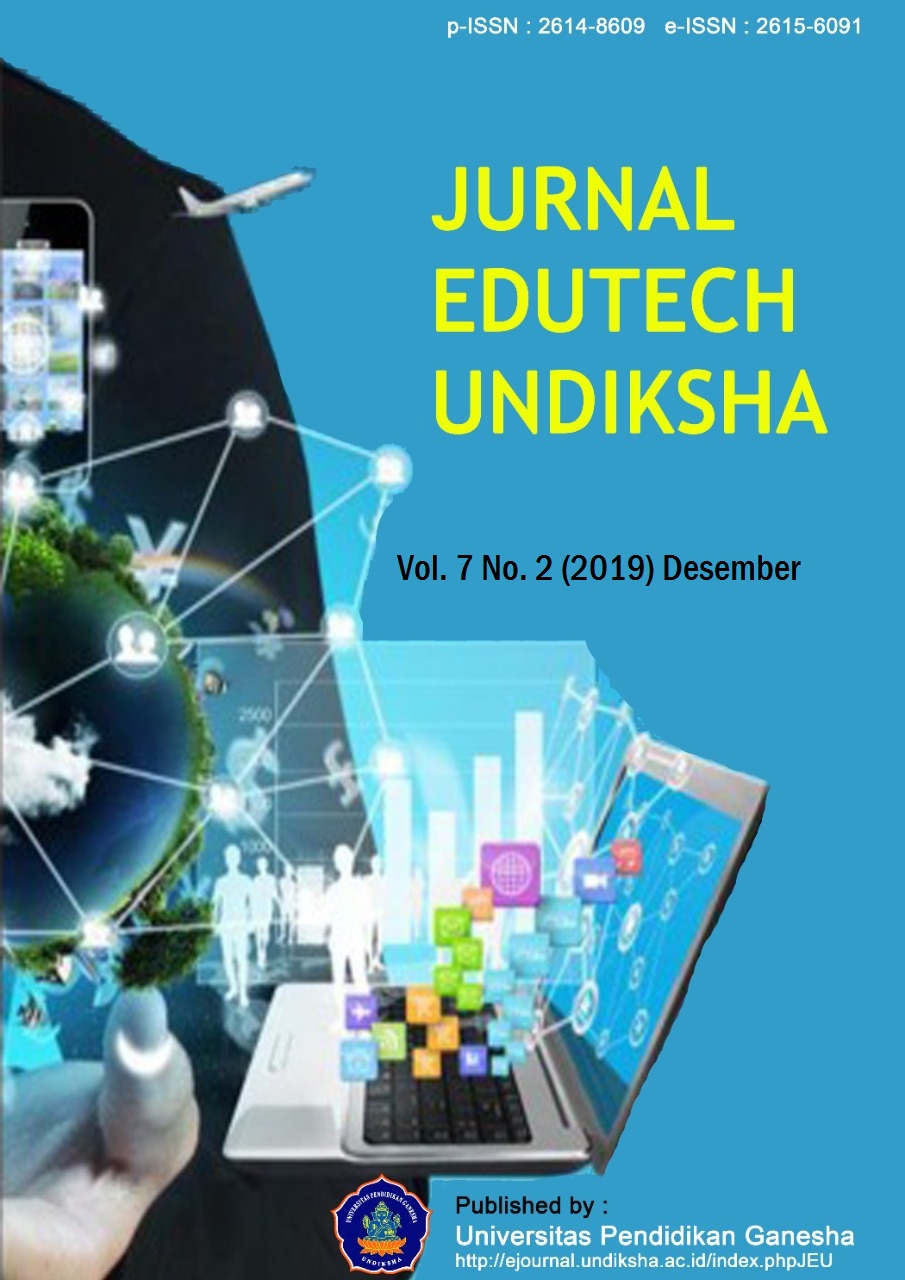Game Education Mata Pelajaran Matematika Untuk Siswa Kelas IV SD Negeri 1 Paket Agung
DOI:
https://doi.org/10.23887/jeu.v7i2.21669Abstract
Penelitian ini dilatarbelakangi oleh permasalahan hasil belajar matematika yang rendah dengan rata-rata siswa mendapat nilai 5,8, sedangkan KKM mata pelajaran metamatika adalah 6,5. Tujuan penelitian pengembangan yaitu (1) untuk mendeskripsikan rancang bangun game education, (2) mengetahui validitas game education, (3) mengetahui efektiviitas game education dalam meningkatkan hasil belajar. Analisis data menggunakan analisis deskriptif kualitatif dan, deskriptif kuantitatif dan statistik infrensial (Uji-t). Penelitian ini merupakan penelitian pengembangan dengan model Hannafin and Peck. Hasil penelitian meliputi, (1) pengembangan game education dengan model Hannafin and Peck ini meliputi tiga tahap yaitu tahap analisis kebutuhan, desain, dan pengembangan implementasi, (2) validitas dari game education dari ahli isi diperoleh 95,50% (sangat baik), ahli desain pembelajaran 90,00% (sangat baik), ahli media pembelajaran diperoleh 93,00% (sangat baik). Persentase diperoleh dari hasil uji coba perorangan yaitu 93,33% (sangat baik). Hasil uji coba kelompok kecil 93,15% (sangat baik). Hasil uji coba lapangan 94,41% (sangat baik). (3) Efektivitas game education yang dikembangkan diperoleh t-hitung =10,296, lebih besar dari t-tabel yaitu 2,048. Hal ini menunjukan bahwa H0 ditolak dan H1 di terima. Dengan demikian game education terbukti efektif secara signifikan dapat meningkatkan hasil belajar metematika.Kata Kunci : matematika, game education, hannafin and peck
This research was done based on the problem of student’s low mathematics learning outcomes with the average score was 5.8, while the minimum score of mathematic subject is 6.5. The purpose of this research were (1) to describe the educational game design, (2) find out the validity of the educational games, (3) and to know the effectiveness of educational games in improving learning outcomes. Method of data analysis used were descriptive qualitative, quantitative descriptive analysis, and statistical statistics (t-test). This research was a research and develop model with Hannafin and Peck model. The results of the study, such as; (1) the development of educational games which used Hannafin and Peck model involving three analytical stages, such as need analysis, design, and implementation development, (2) the validity of the educational game based on content experts obtained 95.50% with very good qualifications, learning design experts shows 90.00% (very good), instructional media experts get 93.00% (very good). The percentage obtained from the results of individual trials is 93.33% (very good). The results of small group trials were 93.15% (very good). Field trial results 94.41% (very good). (3) The effectiveness educational game development obtained t-count = 10.296, higher than t-table that is 2.048. This shows that H0 was rejected and H1 was accepted. Thus the educational game has been proven to be effective in increasing student’s mathematic learning outcomes.
keyword : mathematics, educational games, hannfin and peck
Downloads
Published
2019-11-28
How to Cite
GUNA, I. M. D., Agung, A. A. G., & Pudjawan, K. (2019). Game Education Mata Pelajaran Matematika Untuk Siswa Kelas IV SD Negeri 1 Paket Agung. Jurnal Edutech Undiksha, 7(2), 14–23. https://doi.org/10.23887/jeu.v7i2.21669
Issue
Section
Articles
License
Authors who publish with the Jurnal Edutech Undiksha (JEU) agree to the following terms:
- Authors retain copyright and grant the journal the right of first publication with the work simultaneously licensed under an Attribution-ShareAlike 4.0 International (CC BY-SA 4.0) that allows others to share the work with an acknowledgment of the work's authorship and initial publication in this journal.
- Authors are able to enter into separate, additional contractual arrangements for the non-exclusive distribution of the journal's published version of the work (e.g., post it to an institutional repository or publish it in a book), with an acknowledgment of its initial publication in this journal.
- Authors are permitted and encouraged to post their work online (e.g., in institutional repositories or on their website) prior to and during the submission process, as it can lead to productive exchanges, as well as earlier and greater citation of published work. (See The Effect of Open Access)








